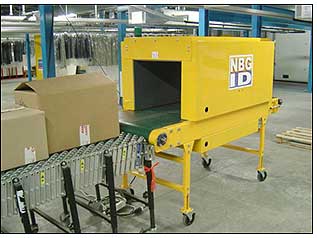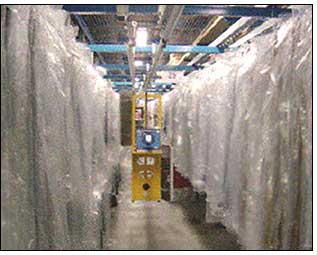DHL Solutions Fashion, a global logistics service provider for clothing manufacturers and retailers, is offering the French fashion industry a way to test item-level RFID tagging of garments in order to help speed the delivery of their products as well as enable shipments to be tracked through the supply chain.
During the summer, DHL worked alongside NBG-ID, RFID specialist based in Cavaillon, France, to deploy an RFID network in a 500-square-meter room at DHL’s Paris distribution center. In July, DHL ran a trial of its new RFID capabilities with one of its customers. Now, the company says it is looking to offer its RFID services to other customers looking to incorporate RFID into their operations.
According to DHL Solutions Fashion, RFID is well suited to reducing the complexity of the taking inventory as well as speeding up inventory and delivery checking involved in distribution in the garment supply chain.
“The garment industry has unique requirements because retailers are locked in a battle to get key fashion trends from the design table to the shelves as quickly as possible, RFID technology offers the logistical advantages to respond to this challenge,” says Christophe Cavailles, director of DHL Solutions Fashion.
DHL Solutions Fashion’s Paris distribution center serves as a hub between a number of different fashion clothing suppliers, mostly in France, as well as boutique operators, also mostly in France. Each year, 70 million garments pass through the center on their way to wholesale suppliers.
DHL’s RFID-enabled room contains three ways to read garment tags. A portal equipped with two antennas reads tags on clothing shipped while hanging on a rail. For garments shipped in boxes, a tunnel reader with three antennas surround a conveyor and read tags as the boxes move along the conveyor. A mobile reading system with two antennas rides on ceiling-mounted rails and is pushed manually through the room to carry out full inventories. According to NBG-ID, it takes 30 seconds for this mobile system to take an inventory of 20,000 hanging garments. The mobile system can also be used to search for a specific item.
The trial at the distribution center in July tracked the new autumn/winter collection from Véronique Delachaux, a maternity clothing label that is part of Jacadi Group. In total, 30,000 Delachaux clothing items passed through the center en route to the Jacadi’s 13 warehouses as well as to retailers. Véronique Delachaux paid for the tags, and DHL covered other costs.
The trial used the NBG-ID FashionChip RFID tag—both in the form of a self-adhesive label (which uses EM-Microelectronic‘s EM4222 inlay) and a hangtag (manufactured by Sophia-Antipolis, France -based smart card and smart ticket specialist ASK S.A.). According to NBG-ID, the read only smart labels and hangtags are priced at 200,000 euros per million (0.20 per tag), but in smaller volumes, the price can increase to 0.30 per tag.
The credit-card-sized smart labels and hangtags were manually attached to boxes and to clothing items, respectively, at Véronique Delachaux warehouses prior to shipping to DHL. Each smart label or hangtag’s embedded RFID tag was associated with the same data that was associated with a bar code also printed on that label or hangtag. The data includes the size of the garment, its color and a reference number.
It was critical that the smart labels and hangtags carry both an RFID inlay and a bar code. “Retailers are not ready yet to get rid of the bar code system,” says Bruno Favre, CEO of NBG-ID.
The tagged garments were then shipped to DHL Fashion distribution center to be inventoried and redirected according to the shipping instructions from Véronique Delachaux. DHL Solutions Fashion claims that using of RFID tags dramatically reduced the time needed to unload a truck and check all the goods into the distribution center. A shipment of 450 tagged garments hanging on a rail with 450 clothing items was scanned in 2 minutes, while the same task with bar codes takes 8 minutes.
“What is critical for this solution is to ensure that the system is 100 percent reliable and that all tags are read, even when very close to each other,” says Favre, who claims that NBG-ID’s system offers this level of reliability. For competitive reasons, however, he declined to explain how.
DHL says the RFID-enabled facilities at its distribution center are now available for other clients looking to investigate and test potential RFID systems and then use DHL’s facilities for RFID-enabled shipments. To ensure 100 percent reliability of the system, the number of garments in each box is limited to 40, although that will increase up to 100 garments by spring 2005, according to Favre.
Jacadi says that it is convinced of the efficiency of the system in tracking garments and is seriously considering deploying item-level RFID tagging. It will not do so, however, until it believes consumers are comfortable with RFID. “We clearly think that RFID has the potential to materially change how inventory is managed in the supply chain, but concerns about consumer privacy remain,” says François-Xavier Desgrippes, director general of Jacadi. “For example, the thought that an RFID tag could be located on a clothing item beyond the point of checkout is threatening to many people, as they view this as an invasion of privacy.”



